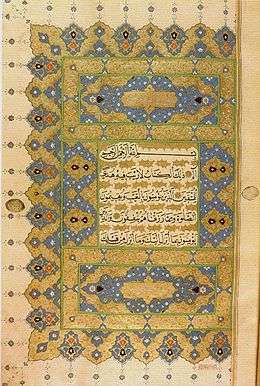Ayah

| Quran |
|---|
 |
|
Āyah (/ˈɑːjə/; Arabic: آية; plural: āyāt آيات) means "evidence" or "sign". In the context of Islam's principal scripture, the Quran, ayah is used to mean "verse", i.e. each statement or paragraph marked by a number.
These are the ayat (proofs, evidences, verses, lessons, revelations, etc.) of God, which We recite to you (O Muhammad) with truth. Then in which speech after God and His signs will they believe?
Overview
Although meaning "verse" when using the Quran, it is doubtful whether "ayah" means anything other than "sign" or "remarkable event" in the Quran's text. The "signs" refer to various phenomena, ranging from the universe, its creation, the alternation between day and night, rainfall, the life and growth of plants, etc. Other references are to miracles or to the rewards of belief and the fate of unbelievers.[1] For example:
- "And of his signs is the creation of the heavens and earth and what He has dispersed throughout them of creatures." (42:29, i.e. sura 42, ayah 29)
- "And a sign for them is the dead earth. We have brought it to life and brought forth from it grain, and from it they eat." (33:33)
- "... and they denied him; therefore we destroyed them. Herein is indeed a sign yet most of them are not believers." (26:139)
- "... you are but a mortal like us. So bring some sign if you are of the truthful." (26:154)
Chapters in the Quran consist of several verses, varying in number from 3 to 286. Within a long chapter, the verses may be further grouped into thematic sequences or passages.
For the purpose of interpretation, the verses are separated into two groups: those that are clear and unambiguous (muhkam) and those that are allegorical (mutashabeh).[2] This distinction is based on the Quran itself: "It is God Who has sent down to you the Book. In it are verses that are 'clear', they are the foundation of the Book. Others are 'allegorical' but those in whose hearts is perversity follow the part thereof that is allegorical, seeking discord, and searching for its hidden meanings, but no one knows its hidden meanings except God. And those who are firmly grounded in knowledge say: We believe in the Book, the whole of it is from our Lord. And none will grasp the Message except men of understanding."[3]
The word ayah is also used to refer to the verses of the Bible by Arab Christians and Christians in countries where Arabic words are used for religious terms.[4]
A common myth persists that the number of verses in the Quran is 6,666.[5] In fact, the total number of verses in all chapters is 6,236, although this varies depending on how (or if) the Basmala appearing at the start of each chapter are counted.
The Unicode symbol for a Quran verse, U+06DD, is: .[6]
The first ayahs in the Quran from a chronological order are Read [O Muhammad!] in the name of your Lord who created. (96.1) He created man from a clot. (96.2) Read, and your Lord is the Most Honorable (96.3) who taught with the pen from sura Al-Alaq. The first ayahs from a traditional order are In the name of God, the Merciful, the Compassionate from sura Al-Fatiha. The first ayahs after the opening sura are Alif Lam Mim. This is the Scripture whereof there is no doubt, a guidance unto those who ward off (evil), from sura Al-Baqara.
See also
References
![]() Media related to Islamic mythology at Wikimedia Commons
Media related to Islamic mythology at Wikimedia Commons
- ↑ Campo, Juan E. (2009). Encyclopedia of Islam. New York: Facts On File. p. 77. ISBN 9780816054541.
- ↑ The Ayahs of the Quran: The Muhkam and the Mutashabih (Association of Islamic Charitable Projects).
- ↑ "Ali-Imran 3:7 from the Yusuf Ali translation of the Quran online at the Quranic Arabic Corpus.
- ↑ For example, "'Yesus' Siapakah Dia?". KabarIndonesia (in Indonesian). Retrieved 21 July 2011.
...Kejadian 1:26. Dengan ayat-ayat dan penjelasan diatas...
- ↑ Hixon, Lex (2003). The heart of the Qurʼan : an introduction to Islamic spirituality (2. ed.). Quest. ISBN 9780835608220.
- ↑ A (scanned) example of the Unicode ayah character is on page 3 of this Proposal for additional Unicode characters.